 W
WInsignias and badges of the United States Navy are military badges issued by the United States Department of the Navy to naval service members who achieve certain qualifications and accomplishments while serving on both active and reserve duty in the United States Navy. Most naval aviation insignia are also permitted for wear on uniforms of the United States Marine Corps.
 W
WThe Achievement Medal is a military decoration of the United States Armed Forces. The Achievement Medal was first proposed as a means to recognize the contributions of junior officers and enlisted personnel who were not eligible to receive the higher Commendation Medal or the Meritorious Service Medal.
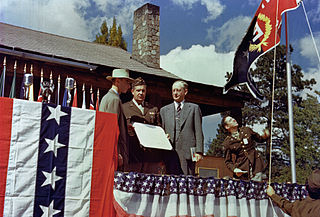 W
WThe Army-Navy "E" Award was an honor presented to companies during World War II whose production facilities achieved "Excellence in Production" ("E") of war equipment. The award was also known as the Army-Navy Production Award. The award was created to encourage industrial mobilization and production of war time materials. By war's end, the award had been earned by only 5% of the more than 85,000 companies involved in producing materials for the U.S. military's war effort.
 W
WThe Battenberg Cup is an award given annually as a symbol of operational excellence to the best ship or submarine in the United States Navy Atlantic Fleet. The cup was originally awarded as a trophy to the winner of cutter or longboat rowing competitions between crews of American and British naval ships. In more recent years it has been presented to the Battle Efficiency "E" winner selected as the best all-around ship of the Fleet based on crew achievements. These include performance in competition for Atlantic Fleet Sportsmanship Award, TYCOM Sailor of the Year Award, Golden Anchor Award, Captain Edward F. Ney Memorial Award, and command excellence awards. Other information, such as operating schedules, commitments and unusual factors contributing to the nomination may also be considered.
 W
WThe Battle Effectiveness Award, is awarded annually to the small number of United States Navy ships, submarines, aviation, and other units that win their battle effectiveness competition.
The Bronze Star Medal is a United States decoration awarded to members of the United States Armed Forces for either heroic achievement, heroic service, meritorious achievement, or meritorious service in a combat zone.
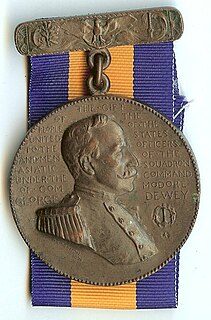 W
WThe Dewey Medal was a military decoration of the United States Navy which was established by the United States Congress on June 3, 1898. The medal recognizes the leadership of Admiral of the Navy George Dewey, during the Spanish–American War, and the Sailors and Marines under his command.
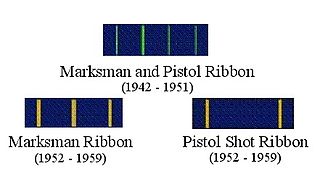 W
WThe Distinguished Marksmanship Ribbon was a United States Navy military award which was established in 1942 as the Distinguished Marksman and Pistol Shot Ribbon. The ribbon recognized those who had been presented a Distinguished Marksman Badge through exceptional scoring at a professional military shooting competition. The Distinguished Marksman and Pistol Shot Ribbon was issued for receipt of either a Rifle or Pistol Distinguished Marksman Badge.
 W
WThe Domain of the Golden Dragon is an unofficial but highly coveted award of the United States Navy and the United States Coast Guard. It is given to crew members of ships which cross the International Date Line. You enter the dragon's empire when you cross the International Date Line by sailing west, where Asian nations celebrate the power of the dragon. With the extensive Navy operations in the Far East since World War II, this passage has become so common that few initiation ceremonies are actually held. But the certificate, decorated with Chinese-style dragon, is still given out.
 W
WThe Fleet Marine Force Ribbon, officially the Navy Fleet Marine Force Service Ribbon, was a military award of the United States Navy established in 1984 by Secretary of the Navy, John F. Lehman, Jr. The service ribbon was awarded to eligible Navy personnel serving with the Marine Corps between 1984 and 2006. The award signified the acquisition of specific professional skills, knowledge and military experience that resulted in qualifications above those normally required of Navy personnel serving with the Fleet Marine Force (FMF). The FMF Ribbon was discontinued in the mid-2000s due to the promulgation of the FMF badges.
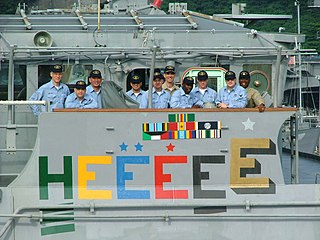 W
WThe Force Health and Wellness Unit Award, commonly known as the Green "H", is awarded annually by Commander, Naval Surface Forces to the U.S. Navy ships, submarines, aviation, and other units in recognition of the unit's commitment to the health and welfare of its sailors and marines.
 W
WThe Good Conduct Medal is one of the oldest military awards of the United States Armed Forces. The U.S. Navy's variant of the Good Conduct Medal was established in 1869, the Marine Corps version in 1896, the Coast Guard version in 1923, the Army version in 1941, and the Air Force version in 1963; the Air Force Good Conduct Medal was temporarily discontinued from February 2006 to February 2009, followed by its subsequent reinstatement.
 W
WThe Jeannette Medal is a Congressional Gold Medal awarded in 1890, to officers and crew of the Jeannette expedition. Eight gold and twenty-five silver medals were struck, resulting in all thirty-three members of the crew receiving a medal. Twenty of the crew died during the expedition.
 W
WThe Marjorie Sterrett Battleship Fund Award is presented annually by the U.S. Navy's Chief of Naval Operations to one ship in the U.S. Atlantic Fleet and one in the U.S. Pacific Fleet. A list of winners appears at the end of this article.
 W
WThe Marksmanship Medal is a United States Navy and the U.S. Coast Guard military award and is the highest award one may receive for weapons qualification. The Marksmanship Medal is the equivalent of the Expert Marksmanship Badge in the U.S. Army and U.S. Marine Corps. Additionally, select State National Guard organizations award marksmanship medals to guardsmen who achieve some of the highest aggregate scores at state-level marksmanship competitions.
 W
WA marksmanship ribbon is a United States Navy, Air Force, and Coast Guard award that is issued to its members who pass a weapons qualification course and achieve an above-average score. Additionally, there are select state National Guard organizations that award marksmanship ribbons for high placement in state-level marksmanship competitions.
 W
WThe Naval Reserve Medal is a decoration of the United States Navy which was created by order of Secretary of the Navy Claude A. Swanson on 12 September 1938. The medal was first issued in 1938 and was an active award until 1958. On 12 September 1958, the Naval Reserve Medal was declared discontinued and was replaced by the Armed Forces Reserve Medal. It is not to be confused with the Naval Reserve Meritorious Service Medal which is a different award that was discontinued on 1 January 2014.
 W
WThe Navy and Marine Corps Medal is the highest non-combat decoration awarded for heroism by the United States Department of the Navy to members of the United States Navy and United States Marine Corps. The medal was established by an act of Congress on 7 August 1942, and is authorized under 10 U.S.C. § 6246.
 W
WThe Navy Cross is the United States Navy and United States Marine Corps' second-highest decoration awarded for valor in combat. The Navy Cross is awarded primarily to a member of the United States Navy, Marine Corps, and the Coast Guard for extraordinary heroism. The medal is equivalent to the Army's Distinguished Service Cross, the Air Force Air Force Cross, and the Coast Guard Cross.
 W
WThe Navy Distinguished Public Service Award, established in 1951, is an award presented by the U.S. Secretary of the Navy to civilians for specific courageous or heroic acts or exceptionally outstanding service of substantial and long-term benefit to the Navy, Marine Corps, or Department of the Navy as a whole. Originally a certificate with a lapel pin, the medal was first presented in July 1951. It is the highest recognition that the Secretary of the Navy may pay to a civilian not employed by the Department of the Navy.
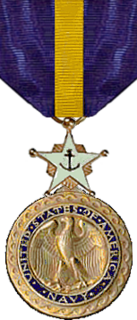 W
WThe Navy Distinguished Service Medal is a military decoration of the United States Navy and United States Marine Corps which was first created in 1919. The medal is presented to recognize distinguished and exceptionally meritorious service to the United States while serving in a duty or position of great responsibility. The award is the Navy and Marine Corps equivalent to the Army Distinguished Service Medal, the Air Force Distinguished Service Medal, and the Coast Guard Distinguished Service Medal. The Navy Distinguished Service Medal was originally senior to the Navy Cross, until August 1942 when the precedence of the two decorations was reversed. Currently, it is worn after the Defense Distinguished Service Medal and before the Silver Star Medal.
 W
WThe Navy Expeditionary Medal is a military award of the United States Navy which was established in August 1936.
 W
WThe Navy Meritorious Public Service Award is the third highest award that the United States Department of the Navy can present to private civilians not employed by the department. Like the other Navy Public Service Awards, it is generally awarded to business and civic leaders, scientists and other civilians who have made outstanding voluntary contributions to the mission and best interests of the Department of the Navy. It recognizes significant contributions with substantial impact upon a specific activity or geographical location. This award may be bestowed upon civilians by all Echelon I and II commanders, or above; and, is in rare cases signed and approved by the Secretary of the Navy.
 W
WThe Navy Unit Commendation (NUC) is a United States Navy unit award that was established by order of the Secretary of the Navy James Forrestal on 18 December 1944.
 W
WA Reserve Good Conduct Medal refers to any one of the five military conduct awards, four of which are currently issued and one of which was previously issued, by the United States Armed Forces to enlisted members of the Reserve and National Guard. The primary difference between the regular Good Conduct Medal and the Reserve Good Conduct Medal is that the regular Good Conduct Medal is only issued for active duty service while the reserve equivalent is bestowed for reserve duties such as drills, annual training, and additional active duty for either training or operational support to the active duty force or, in the case of the Army National Guard and Air National Guard, in support of Title 32 U.S.C. state active duty (SAD) such as disaster response and relief.
 W
WThe Retention Excellence Award is an award given by the United States Department of the Navy for sustaining superior levels of military retention. The award was established by the United States Fleet Forces Command through the Fleet Retention Excellence Program. Deployable Navy ships are authorized to paint their anchors gold as a symbol of earning the award.
 W
WThe Specially Meritorious Service Medal was a military decoration of the United States Navy which was created by Joint Resolution of Congress No. 18 of 3 March 1901. The medal was intended to recognize acts of non-combat meritorious service accomplished during the Spanish–American War.
 W
WThe Spokane Trophy is awarded by Commander United States Pacific Fleet on a cycle basis to the surface combatant ship considered to be the most proficient in overall combat systems readiness and warfare operations. The nomination will be submitted by the type commander based on the recommendations of the ISIC. Because the award is to recognize demonstrated ability to fully conduct, on a sustained basis, simultaneous and coordinated air warfare, surface warfare, and undersea warfare operations with all installed equipment, no check-off list of particular criteria is appropriate nor can a ship explicitly work for nomination for the award other than by routinely striving for the highest levels of combat systems training and material excellence. The actual Spokane Trophy is made of 400 ounces of silver and is valued at $4 million.
 W
WThe Tiffany Cross Medal of Honor arose immediately after World War I, as the US Navy decided to recognize via the Medal of Honor two manners of heroism, one in combat and one in the line of a sailor's profession. The original upside-down star was designated as the non-combat version and a new pattern of the medal pendant, in cross form, was designed by the Tiffany Company in 1919. It was to be presented to a sailor or Marine who "in action involving actual conflict with the enemy, distinguish[es] himself conspicuously by gallantry and intrepidity at the risk of his life above and beyond the call of duty and without detriment to his mission." This pendant became the Tiffany Cross.